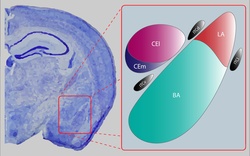Central nucleus of the amygdala
| Central nucleus of the amygdala | |
|---|---|
 |
|
| Identifiers | |
| NeuroLex ID | Central amygdaloid nucleus |
|
Anatomical terms of neuroanatomy
[]
|
|
The central nucleus of the amygdala (CeA or aCeN) is a nucleus within the amygdala. It "serves as the major output nucleus of the amygdala and participates in receiving and processing pain information."
CeA "connects with brainstem areas that control the expression of innate behaviors and associated physiological responses." CeA has dopaminergic projections.
CeA is responsible for "autonomic components of emotions (e.g., changes in heart rate, blood pressure, and respiration) primarily through output pathways to the lateral hypothalamus and brain stem." The CeA is also responsible for "conscious perception of emotion primarily through the ventral amygdalofugal output pathway to the anterior cingulate cortex, orbitofrontal cortex, and prefrontal cortex."
The regions described as amygdala nuclei encompass several structures with distinct connectional and functional characteristics in humans and other animals. Among these nuclei are the basolateral complex, the cortical nucleus, the medial nucleus, and the central nucleus. The basolateral complex can be further subdivided into the lateral, the basal, and the accessory basal nuclei.
The amygdalofugal pathway (Latin for "fleeing from the amygdala" and commonly distinguished as the ventral amygdalofugal pathway) is one of the three principal pathways by which fibers leave the amygdala. The other main efferent pathways from the amygdala are the stria terminalis and anterior commissure. The anterior commissure also serves to connect the two amygdala.
The ventral amygdalofugal pathway carries output from the central and basolateral nuclei and delivers it to a number of targets; namely, the medial dorsal nucleus of the thalamus, the hypothalamus, the basal forebrain, the brain stem, septal nuclei and nucleus accumbens.
...
Wikipedia
